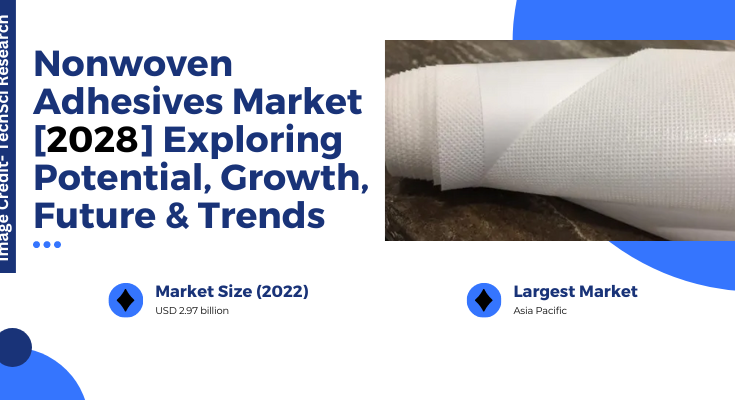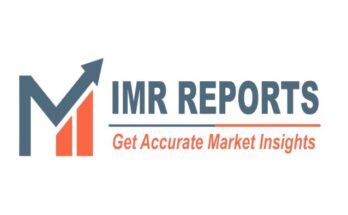According to TechSci Research report, “Nonwoven Adhesives Market – Global Industry Size, Share, Trends, Competition Forecast & Opportunities, 2028”, the Global Nonwoven Adhesives Market is valued at USD 2.97 billion in 2022 and is anticipated to project robust growth in the forecast period with a CAGR of 6.69% through 2028. Technological advancements have played a pivotal role in driving innovation and growth within the global Nonwoven Adhesives market. These advancements have not only improved the performance of nonwoven adhesives but have also expanded their application possibilities, making them a vital component in various industries such as hygiene, healthcare, and automotive.
One significant technological advancement is the development of hot melt adhesives specifically tailored for nonwoven applications. These adhesives offer superior bonding strength and durability while ensuring minimal waste and energy consumption during the manufacturing process. Manufacturers have also made progress in formulating adhesives that are compatible with a wide range of nonwoven materials, including spun-bond, melt-blown, and air-laid fabrics, providing versatility for different applications. In the hygiene industry, technological innovations have led to the creation of nonwoven adhesives that offer advanced properties like moisture management, breathability, and comfort. These attributes are essential for products like diapers, sanitary napkins, and adult incontinence products, enhancing the overall user experience.
Furthermore, in the healthcare sector, nonwoven adhesives have evolved to meet the stringent requirements of medical applications. Advanced formulations ensure that these adhesives are not only strong and reliable but also hypoallergenic, conformable, and safe for use on sensitive skin. This has been crucial, especially during the COVID-19 pandemic, where nonwoven materials and adhesives played a critical role in the production of masks, gowns, and wound dressings.
Technological progress has also addressed sustainability concerns. Environmentally friendly nonwoven adhesives with reduced environmental impact have been developed to align with the growing demand for eco-conscious products. These adhesives are designed to be biodegradable, recyclable, or derived from renewable sources. Moreover, advancements in application technology, such as spray and slot coating systems, have improved the efficiency and precision of adhesive application on nonwoven substrates, reducing waste and production costs.
In conclusion, technological advancements in the global Nonwoven Adhesives market have revolutionized the industry by enhancing performance, expanding application possibilities, and addressing sustainability concerns. As consumer demands continue to evolve, the market is likely to witness further innovations, making nonwoven adhesives an integral part of various industries for years to come.
Browse over XX market data Figures spread through XX Pages and an in-depth TOC on the “Global Nonwoven Adhesives Market” @ https://www.techsciresearch.com/report/nonwoven-adhesives-market/19178.html
The Global Nonwoven Adhesives Market is segmented into type, application, technology, regional distribution, and company.
Based on the Type, the Styrenic Block Copolymer segment emerged as the dominant player in the global market for Nonwoven Adhesives. Styrenic Block Copolymers (SBCs) offer versatile adhesion properties, making them suitable for bonding a wide range of nonwoven materials. This versatility allows them to cater to various industries and applications. SBC-based adhesives provide strong and durable bonds, ensuring that nonwoven materials remain securely attached. This is essential in applications where adhesion must withstand stress, such as in hygiene products or medical dressings.
SBCs exhibit excellent elasticity and flexibility, allowing bonded nonwoven materials to stretch and conform to different shapes without compromising the integrity of the bond. This is valuable in applications where flexibility is required, such as in diapers or wound dressings.SBC adhesives provide a soft and comfortable feel when applied to nonwoven products, which is crucial for applications involving direct skin contact, like disposable hygiene products or medical dressings.
SBC adhesives can be formulated to be either hydrophobic or hydrophilic, depending on the specific requirements of the application. This versatility allows them to cater to diverse markets, including both water-resistant and absorbent products. The Asia-Pacific (APAC) region has emerged as the dominant player in the Non-Woven Adhesive Market, surpassing both Europe and North America. This growth is primarily attributed to the rapid development and expanding economies of countries such as China, India, Thailand, Taiwan, and Malaysia.
The robust economic growth in APAC nations has increased demand across various industries, including non-woven adhesives, as they are essential in manufacturing a wide range of products. In developed regions like Europe and North America, stringent regulations regarding the emission of Volatile Organic Compounds (VOCs) and the production of chemical-based products have opened opportunities for global players to invest in emerging economies where regulations are comparatively less stringent.
Europe has imposed strict policies and regulations that encourage the use and production of bio-based ingredients. This shift towards sustainability has created room for market expansion in regions with more relaxed regulations, such as APAC and the Middle East & Africa.
The less stringent regulatory environment in developing regions like APAC and the Middle East & Africa has made it attractive for adhesive manufacturers to establish manufacturing facilities, capitalizing on the lower operational constraints. The market for non-woven hygiene adhesives and related end-use products in APAC and South America is still evolving. With ongoing technological advancements, these regions offer increasing opportunities for market growth and development.
In summary, the dominance of APAC in the Non-Woven Adhesive Market is driven by its rapid economic development, regulatory differences favoring investment, a shift towards sustainability, opportunities for manufacturing facilities, and ongoing technological progress. These factors collectively position APAC as a key player in the global non-woven adhesive market, with room for further expansion in emerging markets like South America.
Major companies operating in the Global Nonwoven Adhesives Market are:
- Henkel AG
- H.B. Fuller
- Bostik SA
- Beardow Adams Ltd.
- Adtek Malaysia Sdn. Bhd.
- Moresco Corporation
- Dow Chemical Company
- 3M Corporation
- Kraton Corporation
- Evonik Industries AG
Download Free Sample Report @ https://www.techsciresearch.com/sample-report.aspx?cid=19178
Customers can also request for 10% free customization on this report
“The global Nonwoven Adhesives market has experienced notable growth in recent years, driven by several key factors. Nonwoven adhesives are crucial in various industries, including hygiene products (like diapers and sanitary napkins), medical supplies (such as wound dressings and surgical gowns), and automotive interior applications (like upholstery and insulation). As these sectors continue to expand, the demand for specialized nonwoven adhesives has surged.
One of the primary drivers of market growth is the increasing awareness of hygiene and personal care, particularly in emerging economies. The need for high-performance nonwoven adhesives in these products, such as those offering comfort, breathability, and moisture control, has led to substantial market growth. Moreover, the healthcare sector’s rising demand for nonwoven medical products, especially in the wake of the COVID-19 pandemic, has further boosted the market. Nonwoven adhesives are integral to the manufacturing of medical masks, gowns, and wound care products. However, the market faces challenges related to sustainability and environmental concerns, which have prompted innovations in eco-friendly adhesive solutions. Nonetheless, the global Nonwoven Adhesives market is expected to continue its growth trajectory, driven by evolving customer preferences, technological advancements, and the increasing adoption of nonwoven materials across multiple industries. Overall, the market is well-positioned for sustained expansion as it adapts to changing market dynamics and consumer needs,” said Mr. Karan Chechi, Research Director with TechSci Research, a research-based management consulting firm.
“Nonwoven Adhesives Market- Global Industry Size, Share, Trends, Opportunity, and Forecast, 2018-2028 Segmented by Type (Amorphous Poly Alpha Olefin, Ethylene Vinyl Acetate, and Styrenic Block Copolymer), By Application (Adult Incontinence, Baby Care, Feminine Hygiene, and Medical), By Technology (Hot-Melt and Water-Based), By Region and competition”, has evaluated the future growth potential of Global Nonwoven Adhesives Market and provides statistics & information on market size, structure and future market growth. The report intends to provide cutting-edge market intelligence and help decision makers take sound investment decisions. Besides, the report also identifies and analyzes the emerging trends along with essential drivers, challenges, and opportunities in the Global Nonwoven Adhesives Market.
You may also read:
Polyester Hot Melt Adhesives Market [2028] Analysis, Dynamics, and Key Players.
Dental Adhesives and Sealants Market Value, Trends [2028], Economy, Expansion, Leader
Dehydrating Breather Market Analysis, Development [2028], Key Terms
Construction Additives Market [2028] – Analysis, Trends, & Insights
Transparent Conductive Films Market – A Comprehensive Report [2028]
Personal Care Ingredients Market [2028] Exploring Potential, Growth, Future & Trends
Table of Content-Nonwoven Adhesives Market
- Product Overview
1.1. Market Definition
1.2. Scope of the Market
1.2.1. Markets Covered
1.2.2. Years Considered for Study
1.2.3. Key Market Segmentations
- Research Methodology
2.1. Objective of the Study
2.2. Baseline Methodology
2.3. Key Industry Partners
2.4. Major Association and Secondary Applications
2.5. Forecasting Methodology
2.6. Data Triangulation & Validation
2.7. Assumptions and Limitations
- Executive Summary
3.1. Overview of the Market
3.2. Overview of Key Market Segmentations
3.3. Overview of Key Market Players
3.4. Overview of Key Regions/Countries
3.5. Overview of Market Drivers, Challenges, Trends
- Impact of COVID-19 on Global Nonwoven Adhesives Market
- Voice of Customer
- Global Nonwoven Adhesives Market Outlook
6.1. Market Size & Forecast
6.1.1. By Value & Volume
6.2. Market Share & Forecast
6.2.1. By Type (Amorphous Poly Alpha Olefin, Ethylene Vinyl Acetate, and Styrenic Block Copolymer)
6.2.2. By Application (Adult Incontinence, Baby Care, Feminine Hygiene, and Medical)
6.2.3. By Technology (Hot-Melt and Water-Based)
6.2.4. By Region
6.2.5. By Company (2022)
6.3. Market Map
- Asia Pacific Nonwoven Adhesives Market Outlook
7.1. Market Size & Forecast
7.1.1. By Value & Volume
7.2. Market Share & Forecast
7.2.1. By Type
7.2.2. By Application
7.2.3. By Technology
7.2.4. By Country
7.3. Asia Pacific: Country Analysis
7.3.1. China Nonwoven Adhesives Market Outlook
7.3.1.1. Market Size & Forecast
7.3.1.1.1. By Value & Volume
7.3.1.2. Market Share & Forecast
7.3.1.2.1. By Type
7.3.1.2.2. By Application
7.3.1.2.3. By Technology


